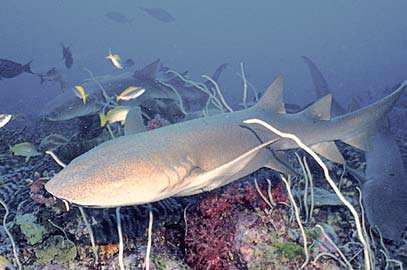GINGLYMOSTOMATIDAE
Nurse Sharks
By Seishi Kimura
 Nebrius ferrugineus |
|
Small to large sharks; maximum size larger than 3 m, but smaller species attaining less than 1 m. Body cylindrical, relatively depressed, without ridges on sides; precaudal tail (distance from posterior end of pelvic-fin base to origin of lower lobe of caudal fin) shorter than head and trunk (distance from tip of snout to posterior end of pelvic-fin base). Nostrils with barbels; nasoral grooves present; no circumnarial grooves. Mouth moderately large, located well anterior to eye; teeth polycuspid, almost similar in both jaws. Eyes without nictitating eyelids. Spiracles much smaller than eyes, situated behind eyes. Five small gill slits, the fifth overlapping the fourth. Two dorsal fins without spines; almost equal-sized or the first larger than the second; first dorsal-fin origin slightly anterior to or above pelvic-fin base; second dorsal-fin origin anterior to or above anal-fin origin; anal-fin base not connected with caudal fin; caudal fin strongly asymmetrical, with a strong subterminal notch. Vertebrae 135-195.Color: head and body dark gray to dark brown dorsally, sometimes with small dark spots or markings. Similar families occurring in the area. Hemiscylliidae: precaudal tail somewhat longer than head and trunk, circumnarial grooves present; spiracle large; anal-fin base connected with caudal fin. Stegostomatidae: caudal fin very long, almost a half of total length; spiracle large. Remarks. Occurring in tropical and subtropical coastal areas of Indo-Pacific, and eastern Pacific, western Atlantic and eastern Atlantic Oceans. Bottom-dwellers. Feed on crustaceans, mollusks, and fishes. |

|
|